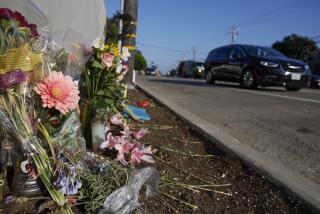Biker’s Suit Against City Thrown Out : Dismissed: A cyclist claims Encinitas could have prevented an accident that left him a quadriplegic by improving a stretch of highway known as ‘Blood Alley.’
- Share via
A North County cyclist paralyzed from the chest down in a 1988 accident along Highway 101 in Encinitas has seen his lawsuit thrown out of court, temporarily sidelining his efforts to remedy the stretch of highway known as “Blood Alley” for the frequency of biking accidents.
David Curnow, a 49-year-old former triathlete who lives in Solana Beach, said Tuesday that his $5-million lawsuit against the city of Encinitas was dismissed last week by a Vista Superior Court judge.
Curnow, a prosecutor with the U.S. attorney’s office in San Diego, has claimed that the city ignored numerous warnings before his accident that the stretch of highway was unsafe.
In the trial, his attorneys claimed that the Tarmac berms commonly used along busy roadways throughout Southern California and the nation may well have protected him from the accident that has rendered him a quadriplegic. Along the road, the city has painted wide white stripes that Curnow says are not adequate and are ignored by many motorists traveling at high speeds.
But last Thursday, Vista Superior Court Judge Runston Maino threw Curnow’s case out of court before the city even presented its defense.
“It’s a devastating kind of decision,” Curnow said. “The judge excluded from the trial evidence that I believe would have proven my case.”
At issue, Curnow said, were several warnings that he claims officials received before his accident. One was a letter reportedly sent to the county in 1986 from the owners along Restaurant Row in Cardiff about increasing speed and traffic along the stretch of coastal road.
Curnow said the city of Encinitas, which incorporated after the letter was sent, conducted its own study of the highway in 1988, detailing the number of accidents at the spot, about 2 miles south of downtown Encinitas.
“We’ve concluded from that study that the city knew of the danger before my accident or they wouldn’t have bothered to even look at the situation,” Curnow said. “But the city says that its precautions along the road meet the state’s minimal standards.
“To me that’s like saying that a person has graduated from high school, but did so with a straight D average. It’s just not enough.”
Robert Heft, an attorney who represented the city of Encinitas in the case, disagreed with Curnow’s assessment of the city’s safety precautions along the highway.
“It’s not a minimum standard, it’s what the regulation is,” he said. Heft said Caltrans regulations call for such thoroughfares to be properly striped and signed. “And the city has complied with those regulations.”
Moreover, Heft said, the Tarmac berms suggested by Curnow are specifically prohibited by Caltrans.
“Officials say that the berms are more dangerous than protective to bicyclists,” he said. “Bikes that drift onto the berm could be thrown out of control, causing them to veer into the lane of traffic. It’s the same with any other obstruction installed to separate bikers from the lanes of automobile traffic--they become more dangerous for all involved.”
In 1988, as he cycled along the roadside, Curnow was struck from behind by a motorist whose car had drifted into the bicycle lane used by countless runners, dog-walkers, roller-skaters and cyclists.
The violent force of the crash threw the lanky Curnow against the car’s windshield and flipped him over the top of the car, leaving his neck broken and his body shattered.
Mounting medical bills forced Curnow two years ago to return to his job as an attorney for the federal Justice Department, a position he had left 14 years before to start his own law practice.
He says some of the money from the failed $5-million lawsuit would have been used to cover his medical bills. “I am a quadriplegic,” he said. “I do not have the use of either my legs or my hands.
“I will have medical bills for the rest of my life. The judge has ruled that the only person responsible for my accident was the driver involved.”
Curnow said he plans to appeal the decision to remedy what he calls one of the most dangerous biking locales in the county.
“They don’t call it ‘Blood Alley’ for nothing,” he said. “Now the judge’s ruling has given the city a blessing, saying that what they’ve done there is just fine. Well, that road looks the same today as the day I was hit, and the same as it did 15 years before that.
“I guess it’s going to take a couple more broken backs, some dead bodies, some dead mothers and their children before anything will be done about it.”
More to Read
Sign up for Essential California
The most important California stories and recommendations in your inbox every morning.
You may occasionally receive promotional content from the Los Angeles Times.














